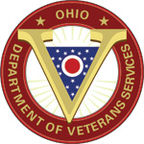- Ohio Department of Veterans Services
-
Ohio Department of Veterans Services (ODVS) 
Emblem of the Ohio Department of Veterans Services Agency overview Formed August 21, 2008 Preceding agency Governor's Office of Veterans Affairs Jurisdiction The State of Ohio Headquarters 77 South High Street, Columbus, Ohio, United States 43215 Employees 1,019 (2010) Annual budget total $98.4 million US$ (2010) Agency executives Thomas N. Moe, Director
Jason A. Dominguez, Asst. DirectorWebsite www.dvs.ohio.gov The Ohio Department of Veterans Services (ODVS) is the organization of state government responsible for identifying, connecting with, and advocating for veterans and their families. ODVS is headquartered in Columbus, Ohio and is part of the executive branch of the Ohio state government. The Director of Veterans Services is part of the Governor's Cabinet.[1]
Contents
History
The Department grew out of the 1990s-era Governor’s Office of Veterans Affairs (GOVA). This organization, working with Ohio legislators, formulated basic changes to laws which began the process of standardizing the operations of the 88 CVSOs, entities which were created in the late 19th century to care for Civil War veterans.
In 2006, a study published by the Institute for Defense Analysis (IDA) provided a major impetus toward the department’s formation. The study said that Ohio was 50th in terms of the per capita dollar amount that veterans in the state received in compensation from the VA. Shortly after, Gov. Ted Strickland convened a study commission of veterans organizations that unanimously recommended the formation of the department.
In 2008, Ohio established the Department of Veterans Services with the passage of Senate Bill 289 in the 127th Ohio General Assembly, a bill sponsored by Sen. Robert Spada and passed with bipartisan support. The mission of the ODVS is to actively identify, connect with, and advocate for veterans and their families. Senate Bill 289 defined the mission and gave the department the responsibility to work directly with the county veterans service officers (CVSOs) and the U.S. Department of Veterans Affairs (VA), as well as with the various veterans service organizations and other concerned associations. [2]
Former state legislator and Korean War-era veteran Bill Hartnett was named by Governor Strickland as the first Director of ODVS. [3]
Responsibilities and Programs
The Department has a wide range of responsibilities, including those defined in section 5902.02 of the Ohio Revised Code (O.R.C.). ODVS advises the Governor on the state of veterans' affairs in Ohio and work as a liaison with other levels of government agencies. It has operational oversight of the 88 County Veterans Service Offices along with oversight of training, certification, and accreditation of more than 600 county veterans service officers, commissioners and staff. It monitors the federal money that comes into the State of Ohio from the U.S. Department of Veterans Affairs and works with the VA on program development, implementation and operations. It address the issues and concerns of more than 70 Veterans Service Organizations. It also keeps 1.7 million records of Ohio veterans who served in WWII, Korea, Vietnam, and OIF/OEF. It is the administrative agent of The Ohio Veterans Hall of Fame. It is the legislative agent for the Office of the Governor regarding any legislation relating to Ohio veterans and their needs.
Veterans Homes
When the department was created it assumed responsibility for the Ohio Veterans Homes (OVH). The homes provide direct nursing home care at facilities in Sandusky and Georgetown as well as domiciliary living to qualified veterans in Sandusky. The Sandusky home opened in 1888 to care for veterans of the Civil War. The home in Georgetown is much newer, having opened in 2003. There are a total of 767 beds maintained between the two homes. [3]
Director
The current director is Colonel Thomas Moe (U.S. Air Force retired). In 1968 his F-4 Phantom was forced down by a weapon malfunction about 20 miles into enemy territory. Although he was able to evade capture for three days, he was eventually captured and held as a POW for over five years until his release during Operation Homecoming in 1973. In 1995 Director Moe retired from the Air Force after serving 30 years active duty and having served in a number of command and staff positions including commander of a combat-ready fighter squadron and vice commander of the Air Force Logistics Command Office of the Inspector General. He earned 24 awards and decorations including two Silver Stars, the Defense Superior Service Medal, two Legions of Merit, the Distinguished Flying Cross, the Bronze Star Medal for valor, two Purple Hearts, and seven Air Medals.[4]
References
- ^ "Governor's Cabinet: Veterans Services". 2011. http://governor.ohio.gov/Administration/Cabinet.aspx. Retrieved November 14, 2011.
- ^ "Senate bill 289". http://www.dispatch.com/content/stories/local/2008/04/17/CASTLE.ART_ART_04-17-08_B1_689V0Q2.html. Retrieved 2011-11-14.
- ^ a b "History of ODVS". http://dvs.ohio.gov/Portals/0/library/odvs/ODVS_Annual_Report_072111.pdf. Retrieved 2011-11-15.
- ^ "Director - Ohio Department of Veterans Services". http://dvs.ohio.gov/home/thomas_n._moe_-_biography.aspx. Retrieved 2011-11-14.
External Links
See also
Categories:- Government of Ohio
- State departments of veterans affairs in the United States
- State agencies of Ohio
Wikimedia Foundation. 2010.
